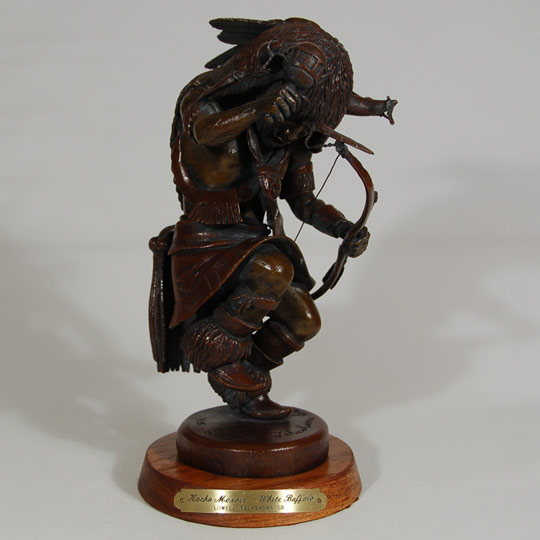Adobe Gallery Blog
Subject: Bronze Sculpture of Kocha Mosair - White Buffalo
Many of the Hopi dances hold social as well as symbolic purposes and act to unite the men and women of the tribe. In the "White Buffalo" dance, a man dresses as and acts the part of the animal; head tucked downward, he paws the earth with his feet and creates movements that recall the animal vividly. The man's partner will be dressed in a very feminine outfit somewhat representing the Palhikmana or Butterfly Maiden Katsina. Danced as a prayer for the increase of buffalo, and is borrowed from another tribe's heritage, this ceremony is a prayer for health and prosperity also.
Elements of ceremonial dress include a kilt, from the back of which emerges a sash that represents the buffalo's tail. The dancer's head covering incorporates horns and frames his face.
Lowell Talashoma, Sr., was a Hopi artist whose bronzes were cast from carvings done by him in cottonwood root. His images were inspired by Hopi belief and "liberated" from the raw material through the artist's vision of what was within. Although he could work faster in preparation for bronzing by using wax or clay, Lowell preferred to interact with the wood, a material he respected for its inherent life and character. The castings made from his carvings via the lost wax method retain that spirit. Even the grain of the original wood can be discerned in the bronze.
This bronze casting of the White Buffalo was issued in an edition of 35 in 1983. This is number 1 of the edition.
Condition: bronze is in original condition.
Provenance: from the estate of a California family
Recommended Reading: Kachinas: a Hopi Artist's Documentary by Barton Wright
Subject: Bronze Sculpture of Kocha Mosair - White Buffalo
Artist / Carver: Lowell Talashoma, Sr. (1950-2003)
Category: Bronze
Origin: Hopi Pueblo
Medium: bronze casting, wood pedestal
Size: 10-3/4" tall including pedestal
Item # C3365E


